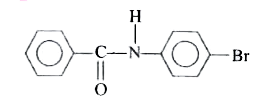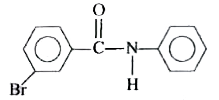Following equation illustrates
C6H5CI+2NaOH200−250∘C−−−−−−→200atmC6H5ONa+NaCI+H2O
Dow' process
Kolbe's process
Carbylamine test
Haloform reaction
To solve the given equation, we will analyze the reaction step by step:
Step 1: Identify the Reactants
The reactants in the equation are:
- C₆H₅Cl (Chlorobenzene)
- 2 NaOH (Sodium hydroxide)
Step 2: Understand the Conditions
The reaction occurs under specific conditions:
- Pressure: 200 atm
- Temperature: 200-250 °C
Step 3: Write the Reaction
The reaction can be written as:
C6H5Cl+2NaOH200atm,200−250∘C−−−−−−−−−−−−→C6H5ONa+NaCl+H2O
Step 4: Identify the Products
The products of the reaction are:
- C₆H₅ONa (Sodium phenoxide)
- NaCl (Sodium chloride)
- H₂O (Water)
Step 5: Recognize the Process
The reaction described is known as the Dows Process, which is a method for producing sodium phenoxide from chlorobenzene and sodium hydroxide.
Step 6: Conclusion
From the analysis, we can conclude that the correct answer to the question is that this reaction illustrates the Dows Process.
Final Answer
The correct option is A (Dows Process).
---
The reactants in the equation are:
- C₆H₅Cl (Chlorobenzene)
- 2 NaOH (Sodium hydroxide)
The reaction occurs under specific conditions:
- Pressure: 200 atm
- Temperature: 200-250 °C
The reaction can be written as:
C6H5Cl+2NaOH200atm,200−250∘C−−−−−−−−−−−−→C6H5ONa+NaCl+H2O
The products of the reaction are:
- C₆H₅ONa (Sodium phenoxide)
- NaCl (Sodium chloride)
- H₂O (Water)
The reaction described is known as the Dows Process, which is a method for producing sodium phenoxide from chlorobenzene and sodium hydroxide.
From the analysis, we can conclude that the correct answer to the question is that this reaction illustrates the Dows Process.
The correct option is A (Dows Process).
Topper's Solved these Questions
Similar Questions
Knowledge Check
Identify (A), (B) and (C ) in the following reaction sequence.
C6H5OH(A)−−→C6H6(B)−−→C6H5NO2(C)−−→AzobenzeneA(A) = Naoh = CaO, (B) = conc. H2SO4+ conc.HNO3,60−70∘C, (C) = glucose + NaOHB(A) = Zn power, (B) = conc. H2SO4 + Conc. HNO3,100∘C, (C) = NH4Cl+ZnC(A) = Zn, (B) = conc. H2SO4+ conc. HNO3,60−70∘C (C) = Zn + NaOHD(A) = NaOH + CaO, (B) = conc. HNO3 + conc. H2SO4, Reflux 24 hrs. (C) =CH3OH+NaThe final product (C) of the following reaction would be:
C6H5−C∣∣O−C6H5H2N−OH−−−−−−→APCl5−−→BBr2/Fe−−−−→C+A B
B C
C D
D
The major product of the following reaction is :
C6H5CH2−CH3∣C∣Br−CH2−CH3C2H5ONa−−−−−→C2H5OH
View SolutionComplete the following equations:
C6H5COOH+SOCl2→
View SolutionIUPAC name of C6H5−O∣∣C−Cl
View SolutionName the following reaction.
C6H5−C≡NSnCl2+HCl−−−−−−−→C6H5−CH=N⊕H2]ClΘH2O−−→C6H5CHO+NH3
View SolutionWhich of the following is pseudo first order reaction?
I. CH3COOC2H5+H2OH+−−→CH3COOH+C2H5OH
II. C12H22O11+H2OH+−−→C6H12O6+C6H12O6
View SolutionWrite the intermediate steps for each of the following reactions
(i)C6H5CH(OH)≡H3O+−−−→C6H5CH≡CHCHO
(ii)
View Solution
